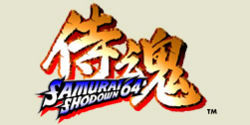Samurai Shodown 64
Samurai Shodown 64 is a 3D computer graphics versus fighting game for the Neo-Geo Hyper 64 system. It was SNK's first attempt to bring one of their franchises into the 3D realm. It received relatively no distribution outside of Japan, and is thus not very well known. After having released two semi-prequel in the Samurai Shodown series on the 16-bit NGH(console), SNK announced that they would be producing a new arcade hardware platform, this one 64-bit and with extensive 3D capabilities.
The game is largely regarded as a curiosity among SNK's faithful, as most fans of the series outside of Japan have never had the opportunity to play it, and it was never ported to any other platform. Being SNK's first attempt to create a 3D fighting game, it has several rough edges, though it is not without merits. The game later received a sequel called Samurai Shodown 64: Warriors Rage.
Storyline
Chronologically, Samurai Shodown 64 takes place one year after Samurai Shodown II. The storyline is described officially by SNK as follows:
"It all began over two decades ago...and took several years to carry out.
'Yuga the Destroyer' seized unborn children throughout the land, provided them with various mysterious skills, and then returned them to their mothers.
The babies were later brought into the world as if nothing had happened.
These infants displayed unique abilities from infancy and were called child gods by some, child demons by others. Over the subsequent decades, they grew to become extremely gifted children, ending up as the true movers and shakers of their generation.
Then one day "Yuga the Destroyer" suddenly appeared before them.
He came to show these individuals who remembered nothing of him...a puppet show.
And those who saw this performance remembered: the missions they were given before they came into this world..."
Gameplay
The gameplay takes full advantage of its 3D engine, with the ability to move in any direction (in a fashion that was later modified and used in Namco's Soul Calibur series). It is also the first 3D fighting game to use multi-tiered stages, where it was possible to knock an opponent through a wall or floor into a different section of the same arena. This idea was later used in Tecmo's Dead or Alive (video game) series, which is frequently (and erroneously) credited for the innovation. It also makes use of the then-traditional setup of being able to knock an opponent out of the fighting area entirely, thus resulting in a victory by "ring out."
Each character also has a "stamina bar" which decreases with excessive movement and attacks, and it replenishes while inactive. There is also a "POW meter", which, once it reaches maximum, allows the player the ability to obtain unlimited stamina for a period of time, and the ability to execute a super move, with devastating results.
Compared to previous games in the series, the overall pace is slower and more methodical. The control scheme also took some growing accustomed to, as special moves tended to have only one version, rather than multiple strengths based on the buttons pressed. The hardware itself was also something of an underperformer, and the visuals were lacking in fine detail, with the textures looking particularly low-resolution. The overall presentation was excellent, however, with excellent music and high-res 2D portraits appearing in various places, such as when certain moves would connect. The game also introduced two new playable characters:
- Yagyu Hanma (Samurai Shodown), a muscular man with a metallic, gigantic arm
- Shiki (Samurai Shodown), a swordswoman proficient in fighting with dual katana, who is later chosen as one of SNK's selectable representatives in the fighting game, SVC Chaos: SNK vs. Capcom and Neo Geo Battle Coliseum.
All in all, the game was not received as well as SNK had hoped, so they sought to remedy the game's problems in the sequel, Samurai Shodown 64: Warriors Rage.
